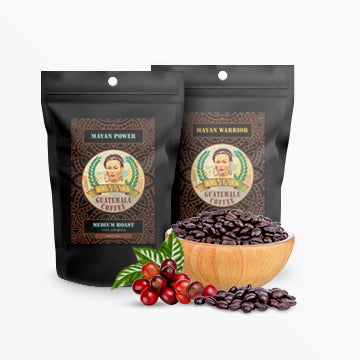Best Espresso Beans for Crema-Rich Shots at Home

That perfect layer of golden crema crowning your espresso shot isn't just for show. It's the telltale sign of a properly extracted espresso that captures aromatic compounds and oils in a velvety foam that enhances both flavor and mouthfeel. The secret? It all starts with choosing the right beans.
Finding the best espresso beans for your home setup can transform your morning routine from mediocre to magnificent. But with countless options flooding the market, how do you separate the exceptional from the ordinary?
What Makes Great Espresso Beans
The foundation of exceptional espresso lies in understanding what makes certain beans shine in your machine. Fresh roast dates matter more than fancy packaging. Beans roasted within 2-4 weeks of your purchase date will produce significantly better crema than older alternatives.
Oil content plays a crucial role too. Medium to medium-dark roasts typically contain enough oils to create that coveted crema layer without becoming overly bitter. Light roasts often lack sufficient oils, while extremely dark roasts can taste burnt and overpower subtle flavor notes.
Bean density affects extraction time and crema formation. Single-origin beans from high-altitude regions like Guatemala often provide excellent density and complex flavor profiles that shine in espresso applications.
Top Characteristics of Crema-Producing Beans
Roast Level Sweet Spot
Medium-dark roasts hit the perfect balance for home espresso brewing. They retain enough acidity to create bright flavors while developing sufficient oils for rich crema formation. These roasts also forgive minor brewing inconsistencies that commonly occur with home equipment.
Bean Freshness Timeline
Purchase beans with roast dates no older than two weeks when possible. Store them in airtight containers away from light and heat. Use them within 3-4 weeks of the roast date for optimal crema production.
Origin Considerations
High-altitude beans from regions like Guatemala, Colombia, and Ethiopia often excel in espresso applications. These growing conditions create denser beans with more complex flavor compounds that translate beautifully into concentrated shots.
Processing Methods That Enhance Crema
Washed processing methods typically produce cleaner, brighter espresso shots with consistent crema formation. Natural processing can create more complex flavors but sometimes results in uneven extraction that affects crema quality.
Semi-washed or honey-processed beans offer a middle ground, providing both complexity and consistency that works well for home espresso brewing.
Guatemalan Beans: A Standout Choice
Guatemala's volcanic soil and high-altitude growing conditions create exceptional espresso beans. The country's Antigua and Huehuetenango regions produce beans with the ideal balance of acidity, body, and oil content for stellar crema production.
Via Guatemala sources premium beans from these renowned regions, working directly with local farmers to ensure optimal processing and freshness. Our commitment to quality control means each batch arrives at peak flavor potential for your home espresso setup.
You can find our carefully curated selection on Amazon, where we offer convenient delivery of freshly roasted beans right to your door.
Grind Size and Extraction Tips
Even the best espresso beans won't deliver great results without proper preparation. Use a burr grinder to achieve consistent particle size. Fine grind settings work best, but avoid powder-fine consistency that can clog your machine's portafilter.
Aim for extraction times between 25-30 seconds for double shots. Faster extractions often indicate too coarse a grind, while slower extractions suggest over-fine grinding that can lead to bitter flavors.
Brewing Variables That Impact Crema
Water temperature significantly affects crema formation. Target 195-205°F for optimal extraction. Too hot burns the coffee and destroys delicate oils needed for crema. Too cool results in under-extraction and weak crema formation.
Dose consistency matters tremendously! Use 18-20 grams of coffee for double shots. Consistent dosing helps dial in your grind settings and improves shot-to-shot repeatability.
Tamping pressure should remain steady around 30 pounds of force. Uneven tamping creates channeling that ruins extraction and prevents proper crema development.
Storage Recommendations for Maximum Freshness
Store beans in opaque, airtight containers at room temperature. Avoid refrigeration or freezing, which can introduce moisture and damage bean structure. Buy smaller quantities more frequently rather than bulk purchases that sit for weeks.
Consider vacuum-sealed containers if you live in humid climates. Moisture is crema's enemy and will quickly degrade your beans' ability to produce that perfect golden layer.
Equipment Considerations
Home espresso machines vary dramatically in their ability to produce great crema. Look for machines that maintain stable temperatures and provide adequate pressure (around 9 bars) for proper extraction.
Portafilter baskets also influence results. Double-walled baskets help beginners achieve better crema by creating back-pressure, while single-walled baskets allow more control for experienced users.
Common Crema Mistakes to Avoid
Over-tamping compacts grounds too tightly and creates uneven water flow. This leads to bitter flavors and poor crema formation. Light, consistent pressure works better than excessive force.
Using stale beans is the number one crema killer. That perfect golden layer requires fresh oils that dissipate quickly after roasting. When beans look dry or lack aroma, they're past their prime for espresso.
Inconsistent grind sizes create uneven extraction where some particles over-extract while others remain under-extracted. This results in muddy flavors and poor crema quality.
Regional Flavor Profiles to Explore
Central American beans like those from Guatemala offer chocolate and nutty undertones with bright acidity that creates exceptional espresso shots. These characteristics make them particularly suitable for milk-based drinks where the coffee needs to shine through steamed milk.
South American origins provide fuller body and lower acidity that works well for straight espresso shots. African beans can offer fruity, wine-like qualities that create interesting flavor combinations but may require more skill to extract properly.
Making Your Selection
Start with single-origin beans to understand how different regions affect your espresso shots. This knowledge helps you identify preferences before exploring blends that combine multiple origins for balanced flavor profiles.
Via Guatemala's selection includes beans specifically chosen for their espresso brewing characteristics. Our roasting expertise ensures each batch hits that crucial window where oils are developed but not burned, creating optimal conditions for rich crema formation.
Conclusion
Creating cafe-quality espresso at home starts with selecting the right beans and understanding how freshness, roast level, and origin affect your final cup. Focus on recently roasted, medium-dark beans from reputable sources that prioritize quality over quantity.
Remember that great espresso is a combination of quality beans, proper technique, and consistent practice. Start with excellent raw materials like Via Guatemala's carefully sourced beans, then refine your brewing process to unlock their full potential.
Your perfect espresso shot awaits. The golden crema crowning your next cup will be proof that you've mastered the art of bean selection and brewing technique.







